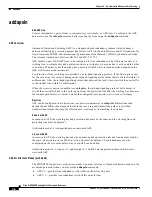
2-98
Cisco MGX 8850 Routing Switch Command Reference
Release 2.0, Part Number 78-10467-04 Rev C0, October 2001
Chapter 2
Shelf Management Commands
telnet
telnet
Telnet to another switch
The telnet command lets you directly telnet to another switch from the current CLI session. Therefore,
you do not have to exit the current CLI session and start a new telnet session to reach another switch.
This command requires 2.1 or higher software.
No limit exists on the number of telnet hops you can take from an individual CLI session. However, an
individual node has a limit of 15 telnet sessions. Therefore, a limit of 15 users can start telnet sessions.
Cards on Which Command Executes
PXM45
Syntax
telnet [-E <escape character>] [-R <traceroute character>] <ip addr>
[[0x|X|x] <tcp port>]
Syntax Description
Related Commands
exit, bye
Attributes
-E
(Optional.) The escape character for terminating the next telnet session in the chain.
The purpose of the escape sequence (Esc key then escape character) is to terminate
the telnet attempt if the destination node is unable to accept the telnet session for
reasons such as: the destination switch is down or unreachable; its in backup boot
mode; or it detects that TCP communication is down. If you use the escape sequence,
the session falls back to the first switch in the telnet chain. The default value for
escape character is “Q.”
-R
(Optional.) The character for triggering a printout of details for all successive hops in
the telnet session. The default value for the traceroute character is “g.”
ip addr
The IP address of the next switch in the chain.
tcp port
(Optional.) The destination tcp port. The default TCP port is identical to the
destination telnet port. Most applications call for the default.
In addition, by default you can enter the number in decimal format, but you can also
enter the optional TCP port address in hexadecimal format by preceding the TCP
destination with any one of the strings “0x,” “X,” or “x.”
Log: no log
State: active, standby, init
Privilege: ANYUSER
















































